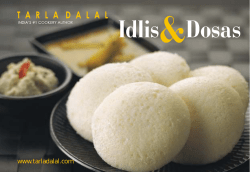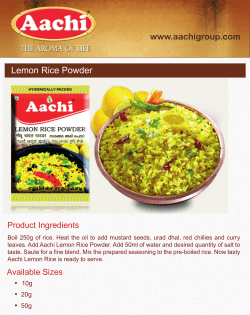
www.tarladalal.com
www.tarladalal.com g Dear friends, Gone are the days when dals and pulses were considered a poor man's diet! Today, they have become not just trendy but core to Indian cuisine. Much of the newfound excitement with regard to vegetarian cooking is fuelled by the imaginative use of dals and pulses. The simple, highly-nutritious and comforting dal-chawal (lentil-rice) combination is an inseparable part of any traditional, Indian vegetarian meal. The protein-packed super-foods, dals and pulses, have been, and continue to be, a part of our culinary tradition across the length and breadth of the country since time immemorial. But we take these wholesome ingredients so much for granted that very few of us would actually be able to differentiate toovar dal from arhar and red chana from kala chana! Well, they are the same, aren't they? We look only at the end-product and think that all dals and pulses look and taste similar; what is there in it! But the surprising fact is that in the raw form dals and pulses come in different colours, flavours and with varying degrees of nutrient-content. And it is not at all difficult to understand them; all it takes is a little time and inclination. Recently, on the 'Ask Tarla' section of our website, I received a query from an 18-year-old who was just foraying into the art of cooking. She wanted to cook moong dal, but was faced with three different versions of yellow-coloured dal toovar, chana and moong and she wanted to know which of these was moong and how to differentiate it from the other two dals. That is when the idea for this book got seeded in my mind. This book is an effort to introduce you to the world of dals and pulses and to demystify the many varieties, so that the next time you go to a shop you can tell the difference between urad dal and moong dal, and certainly they are two different dals! Not to forget the bounty of recipes including Spicy Urad Dal Puri, Masoor Biryani, Methi Dal Dhokli and Vaal ki Usal. Feast healthy! Regards 6 AN INTRODUCTION TO THE WORLD OF DALS AND PULSES 8 STORAGE OF DALS AND PULSES 9 PREPARING THE DALS AND PULSES FOR COOKING 11 Urad Akha Urad - Dal Makhani ................................13 Chilkewali Urad Dal - Khatta Urad Dal......... 15 Urad Dal - Spicy Urad Dal Puris..................... 17 27 Chana Kabuli Chana - Peshawari Chole .................... 29 Hara Chana - Hara Chana Curry with Methi Muthia ..................................................... 31 Kala Chana - Sundal ......................................... 33 Chana Dal - Dal Pakwan .................................. 35 43 Toovar Toovar - Masala Toovar .................................. 45 Toovar Dal - Methi Dal Dhokli ....................... 47 19 Moong Moong - Moong Sprouts Pav Bhaj.... 21 Chilkewali Moong Dal - Stuffed Moong Dal Chilas ............................... 23 Yellow Moong Dal - Moong Dal Sheera.................................................... 25 37 Masoor Masoor - Masoor Biryani ................... 39 Masoor Dal - Hearty Red Lentil Soup........................................... 41 50 Vaal Vaal - Vaal ki Usal ................................52 Vaal Dal - Vaal Dal Khichdi............... 54 Rangoon Vaal - Rangoon na Vaal .... 56 58 Chawli Chawli - Masala Chawli.............................60 Red Chawli - Kadala Curry...................... 62 Chola Dal - Chola Dal Dhokla ................. 64 69 Vatana Hara Vatana - Kovalam Mutter .............. 71 Safed Vatana - Ragda Patties................... 73 Kala Vatana - Pumpkin Koottu Curry ... 76 66 Matki Matki - Nutritious Tendli and Matki Subzi............................. 67 78 Rajma Red Rajma - Tortilla Bake ........... 80 Shaded Rajma - Rajma Salad....... 84 Kashmiri Rajma - Rajma Curry... 86 88 LESSER KNOWN DALS Kulith Kulith Saar ................................................. 89 94 Haricot Beans Macaroni Hot Pot....................................... 95 91 Black Beans Black Bean Soup ........................... 92 MOONG DAL SHEERA Inseparable from Gujarati and Rajasthani cuisine, this moong dal dish is a great value-add for any festive fare! Remember to cook the dal for a long time on a low flame. Yellow Moong Dal Preparation Time : 10 minutes. Cooking Time : 40 minutes. Serves 4. Soaking Time : 3 to 4 hours. Yellow Moong Dal 1 cup yellow moong dal (split yellow gram) A few strands of saffron (kesar) 1 cup milk, warmed 6 tbsp ghee 1¼ cups sugar ½ tsp cardamom (elaichi) powder For the garnish Almond (badam) and pistachio slivers A few strands of saffron (kesar) 1. 2. 3. 4. Clean, wash and soak the moong dal in water for 3 to 4 hours. Drain and blend in a mixer to a coarse paste using very little water. Keep aside. Dissolve the saffron in 1 tbsp of warm milk and keep aside. Heat the ghee in a broad non-stick pan, add the moong dal paste and cook on a medium flame till it becomes golden brown in colour, while stirring continuously. 5. Add the remaining warm milk and 1 cup of warm water and cook on a medium flame, while stirring continuously, till all the liquid is absorbed. 6. Add the sugar and cook on a slow flame till the ghee separates, while stirring continuously. 7. Add the saffron and cardamom powder and mix well. Serve hot garnished with almond and pistachio slivers and saffron strands. PESHAWARI CHOLE One of Peshawar's cultural contributions to this world is its luscious cuisine. Peshawari Chole is a characteristic dish, very popular in Punjab. Spicy and 'chatpata', this dish needs some prior planning as the chick peas require soaking for at least 6 hours. 1 cup kabuli chana (white chick peas) 1 tbsp chana dal (split Bengal gram) 2 big cardamom (moti elaichi) 25 mm. (1”) stick cinnamon (dalchini) 1 teabag 4 tbsp oil 1 cup chopped onions 1½ tsp pomegranate (anardana) seeds roasted and powdered 1 cup chopped tomatoes 1 tbsp finely chopped ginger (adrak) 2 tsp finely chopped green chillies 1 tsp coriander (dhania) powder ½ tsp chilli powder ½ tsp garam masala 1 tsp chole masala Salt to taste Kabuli Chana Preparation Time: 15 minutes. Cooking Time: 1 hour. Serves 4. Soaking Time : Overnight. Kabuli Chana 1. Clean, wash and soak the kabuli chana and chana dal in enough water overnight or for 6-8 hours. 2. Drain, wash again, add 2 cups of water, big cardamom, cinnamon and teabags and pressure cook for 1 whistle. 3. Reduce the flame and cook for 20 minutes. 4. Allow the steam to escape before opening the lid. 5. Strain and reserve the liquid but discard the tea bag. Keep the kabuli chana liquid aside separately. 6. Heat the oil in a kadhai, add the onions and sauté till they turn translucent, while stirring continuously. 7. Add the pomegranate seed powder and cook, till the onions turn dark brown while stirring continuously. 8. Add the tomatoes, ginger and green chillies and cook on a medium flame for 3-4 minutes. 9. Add the coriander powder, chilli powder and garam masala and sauté till the tomatoes are cooked and the mixture leaves oil. 10. Add the cooked kabuli chana, chole masala, the reserved liquid and a little salt if required and mix gently. 11. Cook for 15-20 minutes on a slow flame till some of the liquid dries up. Serve hot with puris. Although an exciting, inseparable and valuable part of Indian cuisine, dals are not given the attention they deserve. Many today do not even know the difference between common varieties like urad, moong and toovar let alone know about the rarer ones like haricot beans. Nor do they know that the repertoire of recipes that can be made with dals extends beyond the common dal-chawal and dalroti combos! This book is an attempt to demystify the world of dals and to provide detailed information and interesting recipes like Khatta Urad Dal, Dal Pakwan, Masala Toovar for inexperienced as well as experienced food enthusiasts. Revel in the goodness of dals! Dal Makhani “Padma Shri” awardee, Mrs Tarla Dalal is India's best selling author in any field, with over 4 million cookbooks sold to date. She is the first to launch a bi-monthly food magazine, ‘Cooking & More’, which is the best selling cookery magazine in India, under her own name. ISBN 978-818949175-8
© Copyright 2024














